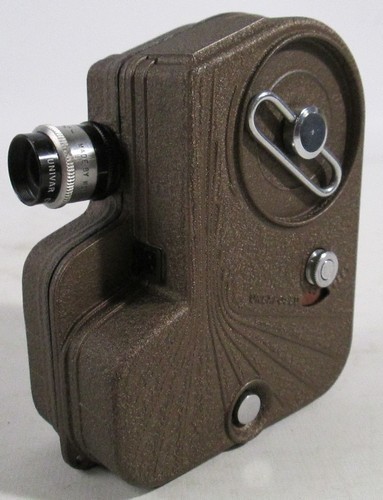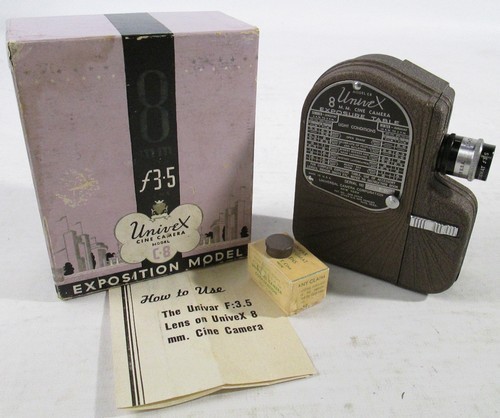
Transport: Spring-wind
Exposure: manual
Approx. date of manufacture: Christmas 1938 to 1941
Approx. original price: $12.50 to $47.25, depending on lens speed. $21.50 in this configuration
"Those who remember the Universal Camera Corporation are prone to a derisive reaction when its products are mentioned. . . . One former employee of Universal interviewed for this book turned blue with anger as he thought back thirty years and became so enraged that he was literally speechless. We never learned the reason for his unusual reaction." —from the book Glass, Brass & Chrome by Kalton C. Lahue and Joseph A. Bailey, p.163
Universal (aka UniveX) was one of the most colorful and interesting manufacturers in the USA. They began in the Great Depression making simple little cameras that took a proprietary film format. By keeping the cost of the cameras, film and processing cheap, they tapped into a huge demand for photos from people who couldn't even afford Kodak Brownies. Their primary retail sales were through dime stores and newstands.
By the middle of the '30s, they figured out how to make a cut-rate movie camera that was "good enough" for the price. Their first model, the A8 (they're all 8s, for 8mm film they used) used a 30 foot spool of "single 8" film, using a spool that made it incompatible with other cameras. But the film and processing were cheap enough, and if you ran it through a UniveX projector, you got a good-enough image for the money.
This C8 was a big revision over the A and B versions. The C8 is commonly called the Exposition model, after the 1939 Golden Gate Exposition in San Francisco; UniveX had a exhibit there. At the same time they also had one at the 1939 World's Fair in New York, where they also had an exhibit.
 There aren't many differences between the A, B and C models. The A and B are identical except that the B came had the A's accessory viewfinder as standard. For the C model, they replaced the open-frame viewfinder with an optical one built into the body; the cover was hinged and self-locking; and there were improvements to the shutter and the film transport system. That makes the C more desirable from a performance point of view.
There aren't many differences between the A, B and C models. The A and B are identical except that the B came had the A's accessory viewfinder as standard. For the C model, they replaced the open-frame viewfinder with an optical one built into the body; the cover was hinged and self-locking; and there were improvements to the shutter and the film transport system. That makes the C more desirable from a performance point of view.
As with earlier models, you could get this with five different lenses of various speeds—the faster the lens (the lower the number), the more expensive it was. The base lens was an Ilex ƒ/5.6, which kept the price of the camera down to $12.50. My camera here came with a Wollensak ƒ/3.5, about 1-1/2 stops faster, and listed for $21.50. The fastest lens in the lineup was a Wollensak ƒ/1.9, which pushed the price over $47. That's a lot of loot on the eve of World War II.
One thing about UniveX movie cameras which surprises me is that they offered an adapter so the owner could use standard D-mount lenses. But I suppose that was a good marketing gimmick, figuring most of their customers would likely buy another UniveX mount lens anyway if they bothered at all.
The C8 was also offered in a 3-lens turret version called the CT8. For that you got typically go three Wollensak ƒ/3.5 lenses: one 1/2-inch, 1-inch, and 1-1/2-inch focal lengths.
Partly because they're movie cameras, and partly because they're essentially filmless orphans, UniveX movie cameras don't carry much residual value. I was very fortunate: this one came with a box and the owner's manual. There were actually several box versions. I believe the color of the box might indicate the lens speed: my Eposition blue box says ƒ/3.5 on it; a Exposition box I saw on eBay (and another on Etsy) was red and said ƒ/5.6. A yellow box on eBay said ƒ/4.5. A 1939 World's Fair box was gray (with the ƒ/3.5 lens).

